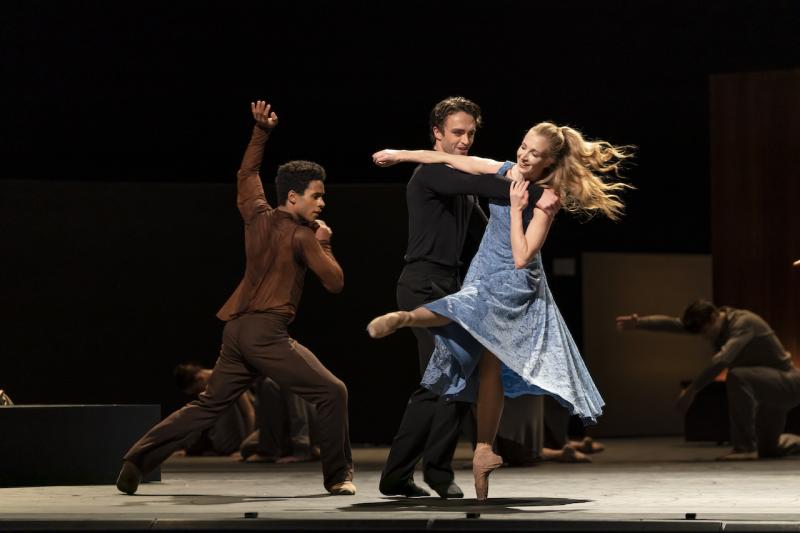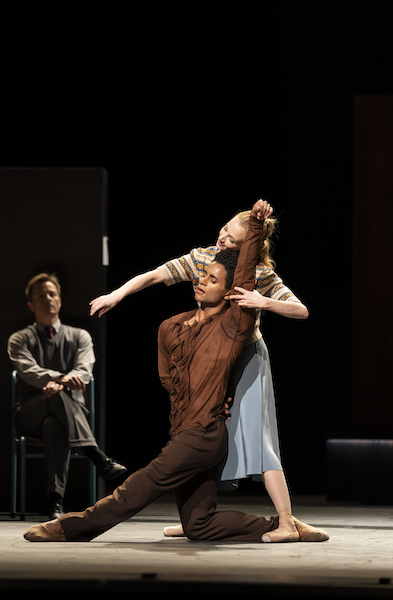The Cellist/Dances at a Gathering, Royal Ballet review - A grand love affair with a cello | reviews, news & interviews
The Cellist/Dances at a Gathering, Royal Ballet review - A grand love affair with a cello
The Cellist/Dances at a Gathering, Royal Ballet review - A grand love affair with a cello
The relationship between a great musician and her instrument, vividly imagined in dance

The cello is the stringed instrument most closely aligned to the human voice. It has a human shape, too, so in theory it was a short step for choreographer Cathy Marston to give it a living, breathing presence in her ballet about the legendary cellist Jacqueline du Pré. But what a giant leap of imagination that turned out to be.
Marston’s first work for the main stage of the Royal Opera House, The Cellist is no straightforward biography, still less does it touch on the torrid accusations that fuelled the film Hilary and Jackie, which was based on a book by her siblings and vehemently disputed by her friends. Instead it focuses on the grand love affair between a musician and her instrument, an affair begun in childhood and cruelly curtailed by multiple sclerosis when du Pré was 26.
 On a minimal set (by Hildegard Bechtler) whose sleek wooden curves suggest the instrument’s own, the dancer Marcelino Sambé (pictured right) becomes a vivid embodiment of du Pré’s cello. He is not merely an object to be carted along to auditions and concerts, but a personality who responds to attention, pines when ignored, and sometimes elevates his owner (literally) to a higher plane. If this sounds twee then it’s a credit to the choreographer’s skill and Sambé’s commitment that the dramatic result is emphatically not.
On a minimal set (by Hildegard Bechtler) whose sleek wooden curves suggest the instrument’s own, the dancer Marcelino Sambé (pictured right) becomes a vivid embodiment of du Pré’s cello. He is not merely an object to be carted along to auditions and concerts, but a personality who responds to attention, pines when ignored, and sometimes elevates his owner (literally) to a higher plane. If this sounds twee then it’s a credit to the choreographer’s skill and Sambé’s commitment that the dramatic result is emphatically not.
Our first sight of Sambé is almost foetal, curled around a cello case on the floor – an old soul awaiting his next incarnation. Child Jackie (Emma Lucano from the Royal Ballet School), at her first lesson, struggles to stretch her bowing arm around Sambé’s broad chest, or spread her small hands on the fingerboard presented by his arm. As her talent takes wing, the body language grows in dynamism, the teenage Jackie (Lauren Cuthbertson) swaying and leaning in, with Sambé luxuriating in her wildly joyous embrace. Philip Feeney’s score stylishly intersperses his own music with exerpts from du Pré’s repertoire – Fauré, Rachmaninov, and of course the Elgar concerto. We see the effect on her of her first encounter, then marriage, with the pianist Daniel Baremboim – Matthew Ball a darting, forceful presence, less forceful as Jackie’s illness starts to bite.
How to present such a hideous personal tragedy without mawkishness? The Cellist comes close but doesn’t cross the line. Marston limits the visible symptoms to a hand tremble and a short scene in which du Pré, believing herself to be in remission, attempts a public recital but cannot start the first bar. Typically, Marston deploys the corps de ballet in myriad ways, as a classful of children, audiences, clamouring record buyers, and memorably as a full orchestra in which each dancer is both player and instrument. Ultimately, the tone of The Cellist is celebratory, underlined by a closing image of Sambé slowly and dreamingly spinning like a vinyl LP.
Dances at a Gathering, first mounted on the Royal Ballet in 1970, the year after its creation, completes the programme. Five couples in turn inhabit an uninterrupted sequence of Chopin piano waltzes, mazurkas and études (performed here from the pit by Rob Clark). These are not your usual bonded ballet couples. They swap about, form threesomes, break off into solos. They behave, in fact, like any group of friends. There is no story, although there is a compulsion to look for one within its lilting blend of folk and classical steps rehearsed to look casual. When Alexander Campbell first appears, alone, for the opening number, a Mazurka, he stands motionless for the first bars gazing at the floor. When he does try a few steps, he merely marks them, before eventually the music siezes him and he’s off.
The genius of this work, and its novelty, lies in the way the choreographer gets under the skin of the dance impulse. Done well, it feels less like a performance than a contemplation. You could have heard an eyelash drop during the closing Nocturne. What happened to all those winter coughs?
rating
Explore topics
Share this article
more Dance
 All You Need Is Death review - a future folk horror classic
Irish folkies seek a cursed ancient song in Paul Duane's impressive fiction debut
All You Need Is Death review - a future folk horror classic
Irish folkies seek a cursed ancient song in Paul Duane's impressive fiction debut
 MacMillan Celebrated, Royal Ballet review - out of mothballs, three vintage works to marvel at
Less-known pieces spanning the career of a great choreographer underline his greatness
MacMillan Celebrated, Royal Ballet review - out of mothballs, three vintage works to marvel at
Less-known pieces spanning the career of a great choreographer underline his greatness
 Carmen, English National Ballet review - lots of energy, even violence, but nothing new to say
Johan Inger's take on Carmen tries but fails to make a point about male violence
Carmen, English National Ballet review - lots of energy, even violence, but nothing new to say
Johan Inger's take on Carmen tries but fails to make a point about male violence
 WAKE, National Stadium, Dublin review - a rainbow river of dance, song, and so much else
THISISPOPBABY serves up a joyous tapestry of Ireland contemporary and traditional
WAKE, National Stadium, Dublin review - a rainbow river of dance, song, and so much else
THISISPOPBABY serves up a joyous tapestry of Ireland contemporary and traditional
 Swan Lake, Royal Ballet review - grand, eloquent, superb
Liam Scarlett's fine refashioning returns for a third season, and looks better than ever
Swan Lake, Royal Ballet review - grand, eloquent, superb
Liam Scarlett's fine refashioning returns for a third season, and looks better than ever
 First Person: Ten Years On - Flamenco guitarist Paco Peña pays tribute to his friend, the late, great Paco de Lucía
On the 10th anniversary of his death, memories of the prodigious musician who broadened the reach of flamenco into jazz and beyond
First Person: Ten Years On - Flamenco guitarist Paco Peña pays tribute to his friend, the late, great Paco de Lucía
On the 10th anniversary of his death, memories of the prodigious musician who broadened the reach of flamenco into jazz and beyond
 Dance for Ukraine Gala, London Palladium review - a second rich helping of international dancers
Ivan Putrov's latest gala was a satisfying mix of stars and young hopefuls
Dance for Ukraine Gala, London Palladium review - a second rich helping of international dancers
Ivan Putrov's latest gala was a satisfying mix of stars and young hopefuls
 Nelken: A Piece by Pina Bausch, Sadler's Wells review - welcome return for an indelible classic
A new generation of gifted performers for us to get to know
Nelken: A Piece by Pina Bausch, Sadler's Wells review - welcome return for an indelible classic
A new generation of gifted performers for us to get to know
 Dark With Excessive Bright, Royal Ballet review - a close encounter with dancers stripped bare
The Royal's Festival of New Choreography launches with an unforgettable walk in the dark
Dark With Excessive Bright, Royal Ballet review - a close encounter with dancers stripped bare
The Royal's Festival of New Choreography launches with an unforgettable walk in the dark
 La Strada, Sadler's Wells review - a long and bumpy road
Even the exceptional talents of Alina Cojocaru can't save dance adaptation of Fellini film
La Strada, Sadler's Wells review - a long and bumpy road
Even the exceptional talents of Alina Cojocaru can't save dance adaptation of Fellini film
 First Person: pioneering juggler Sean Gandini reflects on how the spirit of Pina Bausch has infiltrated his work
As Tanztheater Wuppertal Pina Bausch's 'Nelken' comes to Sadler’s Wells, a tribute from across the art forms
First Person: pioneering juggler Sean Gandini reflects on how the spirit of Pina Bausch has infiltrated his work
As Tanztheater Wuppertal Pina Bausch's 'Nelken' comes to Sadler’s Wells, a tribute from across the art forms
 Manon, Royal Ballet review - a glorious half-century revival of a modern classic
Fifty years on, Kenneth MacMillan's crash-and-burn anti-heroine is riding high
Manon, Royal Ballet review - a glorious half-century revival of a modern classic
Fifty years on, Kenneth MacMillan's crash-and-burn anti-heroine is riding high

Add comment